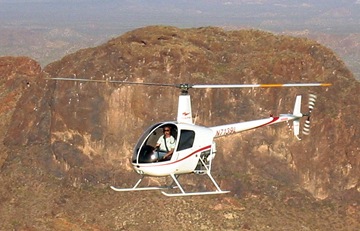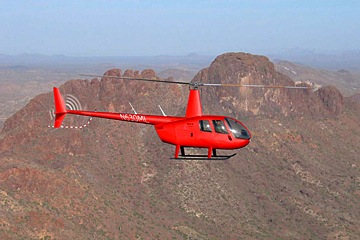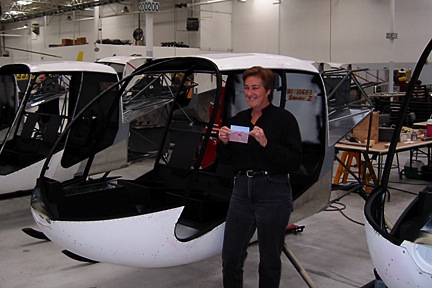Doing your homework is part of flying safely — and legally.
This afternoon, I got a call from a potential client. He’s the manager of a country club that does catering for weddings and other big events. He wanted to know if it were possible for me to land my helicopter on the country club property after dark, pick up a couple — say a new bride and groom — and fly them around Phoenix for about 45 minutes before dropping them off at a hotel with a helipad or an airport where a limousine would be waiting. He also wanted to know whether it was okay for them to have some wine while aboard the aircraft.
Off the top of my head, I said, yes, we should be able to do that. But then I listed the things I’d have to check out before giving a definitive answer.
I thought this might make a good topic for a blog post for commercial helicopter pilots interested in real life helicopter missions. You see, commercial helicopter flying is not always as easy as picking up two passengers at an airport, flying them around for a while, and returning them to the starting point. So, as an example, I’ll discuss the things that come into play for this particular kind flight.
Landing Zone

Off-airport landings are something I’m accustomed to. Photo by Jon Davison.
First and foremost is the safety of the landing zone. How big is it? Is it level? Are there obstacles such as trees, buildings, or wires? What are my approach and departure paths like? Can it be controlled to prevent onlookers from coming too close or walking behind the aircraft? How about neighbors? Are there homes in the area? Is it close to another airport where air traffic control might be an issue? Since landing and departing will be at night, can the landing zone be properly lit so I can find it and land safely on it?
I made an appointment to meet with the client to see the landing zones he had in mind. Hopefully, one will work. I also checked the location of the country club using the satellite view of Google Maps. Although its golf course is indeed surrounded by homes, there’s also a nearby freeway and shopping center that’s likely to be empty at night. I could see some possible approach and departure paths, but could not judge obstacles, such as light posts or wires.
As for a destination hotel — if one is found, I’ll have to go through the entire process there, too. It’s more likely, however, that I’ll just land them at Deer Valley Airport, which is my home base.
Local Ordinances
Of course, no off-airport landing would be possible without a lot of hoop-jumping if there were a local ordinance that prohibited off-airport landings. Scottsdale has such an ordinance, enacted, primarily, to prevent local helicopter pilots from doing asinine things like landing in residential subdivisions. (I guess it was done one too many times.) Wickenburg’s ordinance isn’t quite as restrictive; it states that landing is possible with the permission of the Police Chief. When I asked the Police Chief about this some years ago, he had no idea what I was talking about.
The client said that the mayor the country club’s city is a member, so if there was an issue, he might be able to get permission on an as-needed basis. But when I hung up the phone with him, I started making other calls. First, the local police, to see if they knew of any ordinance. They directed me to the city’s compliance office. They told me they had no ordinances, but that I should check with the FAA. I already know that the FAA is fine with landing a helicopter on private property, as long as it is done safely and in accordance with any related FARs.
So this would not be an issue for this particular location. No hoop-jumping necessary.
Passenger Loading

The lights of Phoenix are beautiful at night. Photo by Jon Davison.
The client wants to use the helicopter as part of the event’s entertainment. At the predetermined time, the guests would be guided to “the patio” (wherever that is) where they could watch the helicopter come in for a landing. The bride and groom would climb aboard and the helicopter would take off, perhaps doing a quick circle of the area before departing.
This sounds great and its sure to make a memorable wedding party. But passenger loading could be an issue here.
Is the client willing to wait for the helicopter to cool down and shut down before the passengers are loaded? And then wait again while the helicopter starts up, warms up, and spins up before departure? If the wait is okay, the pilot (me) can do the passenger briefing and loading. While this might not make for good entertainment, it is the safest option.
The other option is “hot loading,” where the passengers board the helicopter while the engine is running and blades are spinning. Many people will simply not do hot loading, but I will — provided there’s a qualified ground crew to escort all passengers to their seats and ensure they’re buckled in. That means operating with someone on the ground — likely my husband — who would arrive before me and handle briefing and loading duties.
While you might think I prefer the first option, I actually prefer the second. It minimizes the amount of time I’m on the ground and ensures a qualified person is there to handle my next concern: crowd control.
Crowd Control
I firmly believe that a spinning helicopter is more dangerous on the ground than in the air. My tail rotor is literally invisible when it’s spinning — even at idle speed — and if someone walked into it, they’d be dead. That’s why I always set down in a landing zone with my tail pointed away from where people are most likely to be. Any helicopter pilot who doesn’t do this is looking for trouble.
Unfortunately, when landing in an uncontrolled area, there’s nothing to stop people from running up behind the helicopter. There’s a restaurant in Peoria, AZ that I used to land at for lunch quite often. It’s in a relatively remote area with lots of open desert around it. I always landed just outside the parking area with my tail rotor facing away from the building. The last time I landed there, however, a bunch of kids on off-road motorcycles saw me come in and began swarming around the helicopter as I was shutting down. Good thing my husband was with me to keep them clear. I haven’t gone back since.
When I inspect the landing zone, I’ll try to determine how well it can be controlled. And then I’ll put a plan in place to control it for my arrival. Having a reliable and experienced ground crew person will certainly help when the time comes for me to operate there.
Alcoholic Beverages
The final request that requires research is the glass of wine during the tour. FAR 135.121(a) states:
No person may drink any alcoholic beverage aboard an aircraft unless the certificate holder operating the aircraft has served that beverage.
This means they can’t bring their own alcohol aboard — it’s also why you can’t legally bring your own alcohol aboard an airliner!
If you’re wondering who the “certificate holder” is, well, so am I. It’s either me personally — since I have a single pilot Part 135 certificate and I’m the pilot — or it’s my company, Flying M Air. If it’s me, serving wine while I’m at the controls of a helicopter will be nearly impossible. If it’s my company, I can theoretically have an employee or agent of my company serve the alcohol for me, preferably right before we take off.
If there are any pilots out there who have real knowledge about this, please do use the Comments link or form to share what you know with me. Otherwise, I’ll just ask my FAA Primary Operations Inspector (POI). He’ll either tell me or help me figure it out for myself based on what I know.
One thing I do know: if I can’t legally serve alcohol on the flight, I won’t. No client request is more important than my certificate.
FAR 135.121(b) and (c) offer two other rules regarding alcohol:
(b) No certificate holder may serve any alcoholic beverage to any person aboard its aircraft if that person appears to be intoxicated.
(c) No certificate holder may allow any person to bard any of its aircraft if that person appears to be intoxicated.
That means I can’t serve them if they’re drunk and I can’t even allow them to board the aircraft if they’re drunk. This is something I need to make sure the client knows. It would be a shame if I brought my shiny red helicopter in for a landing at the big party and the bride or groom was too shitfaced from champagne to fly. (It would be a bigger shame if one of them puked on my leather seats.)
The Other Usual Stuff
Every flight has the usual collection of pilot tasks before it can be completed. I’m talking about things like calculating weight and balance, getting weather and NOTAM information, creating a flight plan, preflighting the aircraft. I might want to do a daytime landing at the landing zone in advance, just to make sure I was familiar with it. There’s lots of the usual responsibilities, none of which can be taken lightly for any flight.
This Is What It’s All About
This should give most folks an idea of what goes into planning what seems like a simple mission. Any pilot faced with a client request like this who doesn’t look into these things — at a minimum — is simply not doing his job.
I’ll know by Saturday, when I review the landing zone, whether we’ll be able to work for this client. I hope so. It would be great to have some regular gigs like this throughout the year.


 I see these reasons for writing as three separate but overlapping groups that a writer might be part of.
I see these reasons for writing as three separate but overlapping groups that a writer might be part of. So rather than using set theory to illustrate the realities of writing, it might be better to use a pyramid shape with multiple tiers, as shown here.
So rather than using set theory to illustrate the realities of writing, it might be better to use a pyramid shape with multiple tiers, as shown here.



